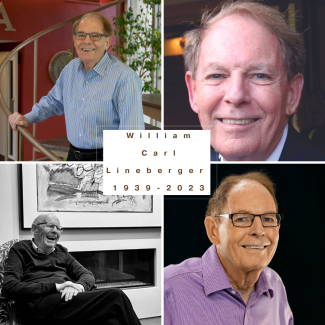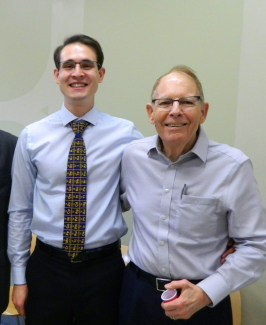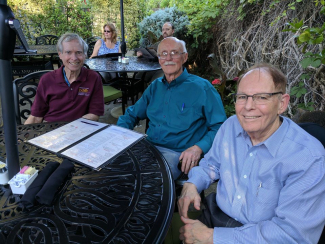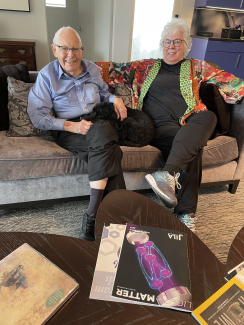| François Amar |
I collaborated (from afar) with Carl and his group in the 1990s on photodissociation of halides in carbon dioxide clusters |
Having done some simulations of Br2 photodissociation in argon clusters while a postdoc with Bruce Berne, I was thrilled when Carl took up the challenge of looking at these kinds of systems experimentally but in anions like I2- in CO2 clusters. This work prompted me to extend the modeling to the anion systems. I was so impressed with Carl's generosity towards a junior colleague like myself and at his capacity to devote resources in terms of student and post-doc time over a long period (~5 years) to working through a tough scientific challenge. A great scientist, a good friend and mentor. |
|
| Max Khaytsus |
I was Carl’s student in his 1990 Experimental Physical Chemistry class. |
Physical chemistry is hard and I grudgingly took a lot of it before ending up in Carl’s class, the last physical chemistry hardship I would need to overcome. Carl made the subject fun and reachable and he had me fully engaged in the class from the first day. He came in one day, saying something like, “I have this great idea for an experiment! No one’s done this before!” and so the class jumped into photoelectron spectroscopy of CuO-. Based on other studies and research we kind of expected where the experiment would go, but Carl warned us that sometimes when you know the answer, science will give you a different one that will change your understanding of physics. Carl introduced us (his Experimental Physical Chemistry class) to his graduate group and we spent several sessions in his lab with his research group doing real science. It was an amazing experience that resulted in a paper and although the copper monoxide anion did not alter the path of science, it was invaluable as a learning experience to understand all the moving parts from idea to research to planning to execution. Carl was there every step of the way, keeping us on the correct path and explaining things that left a pack of students bewildered. I walked out of Carl’s class with a new understanding of experimental science, a passion for research and an “A”, thinking I did not work nearly hard enough to deserve it. Studying never seemed like work when Carl was around. My mother, an analytical chemist, told me when I was going to college that the job of a good instructor is to teach students how to research a problem and how to build a plan to accomplish research, not how to memorize formulae. Carl was one of those instructors. I don’t remember a single equation from his class, but I learned that semester how to solve hard problems and that’s an invaluable skill. |
|
| Allan Maple de Oliveira |
I was Carl's last Ph.D. student from 2012 to 2017. |
I first met Carl via email, he basically was the one to get me admitted into graduate school at CU Boulder, inviting me to do summer research in his group before the semester started. Little I knew that one of the greatest scientists of the century was about to change my life forever.
My time in graduate school was a time of personal growth and of lot of struggles, a time of learning how to be an adult. I think it is pretty common for smart people to believe in the “work smart, not hard” kind of mentality, with the latter part having a bigger weight in the equation, transforming that into something like “I don’t have to work hard because I’m smart”. Carl taught me with much effort that that was not the way to do it. It’s not like I couldn’t be done, instead more like it shouldn’t be done. I was reluctant and naïve to think that I would only dedicate myself to the lab work once I found an unknown passion for what was I doing. I frustrated Carl a lot with this. Today I think understand the kind of commitment one has to put into something, anything really, that one wants to do well. And that the sense of purpose and fulfilment of seeing fruit of the effort greatly surpasses the brief joy of just doing something you like. Carl certainly lived by it, and taught it with action, more so than words.
If I had to shortly describe Carl Lineberger that would be “hard worker”. We used to joke in the lab that one day we would go up to his office and he would be dead at his desk. Carl was one of those people with such a strong work ethic that he would work hard forever, even when he had nothing to prove to anyone and no higher feat to achieve. I know he did that until his very last day.
However, no matter how much stuff he had to do, and how pressing and valuable his time was, he always made time for his students and people who needed help. I remember calling him on the 30 foot-long-cord JILA phone and asking if he was free to talk and he would answer “Not free, but I’m pretty cheap”. In the many late nights fixing the experiment and taking long series of data he would show up excited down in the basement lab to check-up on me (and if the data was good of course). My wife would often bring me a large bowl of homemade popcorn and sometimes keep me company while I was burning the midnight oil. Carl would share the bowl (which he always remarked how nicely seasoned it was) and keep us company too. I remember this dearly… how funny his hair would get after a couple of glasses of wine, his love for good food, travel, learning about new cultures and how awkwardly he would sneak out of the lab when he saw we were fixing some pump or laser. He was a very sweet person with a child-like energy, excitement and sense of humor, so much that it was easy to forget he was a legend in his field.
I was the last student to get a Ph.D. under Carl’s guidance having had the task to permanently shut-off the machines and empty the lab. I hope that I was able to show him that I learned a lot from him and he was proud of the work I did. Time passed, I went through two major career shifts in two different countries, had three kids and now I own and single-handedly operate a small brewery in rural Brazil. The day I found out about his passing I was really shocked and deeply saddened. I had a lot of work to do that day at the brewery, exhausted after putting the kids to bed, work that would take me late into the night, so I thought that maybe I could have a drink in his name. However, the best way I could honor him would be to work my ass off, and so I did. Thank you, Carl. |
|
| Michael D. Morse |
I don't even remember the first time I met Carl. I first heard him speak when he visited the University of Chicago, where I was a graduate student. After that I probably met him at a Gordon Conference. |
Although I never worked in his group, and never spent more than maybe a half-hour with him at a time, I always appreciated his incredible science, his unrivaled insights and most of all his gentle and kind nature. He was always curious, and always eager to explain what he had learned. From the moment I first met him, I thought "I want to be like him." I still strive to fulfill that goal. |
|
| Josef Michl |
I met Carl when he came to deliver a lecture at the University of Utah and we hit it off right away. |
Carl was largely responsible for my move from the University of Texas to the University of Colorado at Boulder. He was very supportive, kindly provided much wise guidance in the initial period, and many hours of scientific discussions thereafter. He was the king (actually, emperor) of gas-phase anions. He was also a great fan of a legendary visitor to JILA, my Czech friend Zdenek Herman, whose recent passing prevented him from writing a story with a deeper insight than I can. Now, Carl himself will remain a JILA legend. |
|
| Robert Parson |
As a faculty colleague in JILA and Chemistry from 1986 to 2023. |
I first met Carl in April of 1986 when he picked me up during a brutal spring snowstorm, on my first visit to CU. I last saw him at his home in September, 2023, a few days before I moved away from Boulder. For the first 3 of those 37 years, we were neighbors on the 8th floor; for the next 30 we were two floors apart. We spent hours in his office on weekday evenings and Saturday afternoons, discussing science (first and foremost), science education and policy, departmental and university politics, and life in Boulder. Carl was a colleague, a friend, and a mentor. We collaborated on papers and proposals and co-advised a graduate student. Of all the lessons that I learned from him, I think the most valuable was that science can still be fun even when it gets hard. Approach the data with patience and humility, and the answers will eventually become clear. |
|
| Michael Barnes |
I knew Carl through my relationship with the Edwards family. |
I have not seen Carl in a few years, but if I saw him tomorrow he is they type of friend where we would pick up where we left off. I will miss him. |
|
| Markus Raschke |
Our interactions have always only been brief since we didn’t have much research overlap. However, Carl has been a role model for me in many aspects since we first meet in 2011. A lot has happened since then, and with much of my success at CU I am in no small part standing on Carl's shoulders. |
I always admired how Carl approached science, his unwavering optimism, his support and commitment to students, colleagues, and the institution. I something think in difficult or frustrating situations of him and how he might address or resolve the issue. |
|
| Beth Kroger |
Carl was a valued colleague and advisor to me in my role as JILA COO. |
I found both the work I love and the people with whom I love to work at JILA. Carl was one of those special JILAns. I am grateful for Carl's guidance, advice, leadership and kindness to me during our work together. His wise counsel and thoughtful approach has been instrumental in keeping JILA the pocket of scientific excellence and collaboration that it is and will continue to influence JILA well into the future. It is my privilege and honor to have had Carl as a colleague and mentor. |
|
| Xavier Xu |
We were in the PChem supergroup and used to meet every week. |
I remember Carl's witty and insightful comments at seminars and group meetings. He was on my defense committee and was always so kind and helpful in all kinds of conversations. I wasn't his student but he invited me to a home party and I was so impressed with his grand bookshelves. |
|
| Jack Simons |
He has been my science hero since the 1970s when I began to study anions. He has also been a good friend and mentor over this long trajectory |
Too many happy memories to contemplate. I view Carl as THE person worldwide who has done the most to characterize the properties and behavior of atomic and molecular anions. He and his scientific offspring have pioneered this field and will continue to lead it even is his (physical) absence. Carl has my highest admiration for his science, his humanity, and his generosity. |
|
| Hannah Sevian |
Carl was my undergraduate research mentor. |
I met Carl in spring semester of my third year of college in 1985 when I added his quantum mechanics course about 4 weeks into the semester as an elective after I dropped cell biology (I had been working without success on getting my mother to accept that I wasn’t going to go to medical school). Following the first exam, the week after I added his class, Carl asked me to stay after class, and then told me that I was going to join his research group. He then set about convincing my mother (who was an administrative assistant in astrophysics) that with my chemical engineering degree, I would be better off working in his lab and then going to graduate school in chemical physics than either medical school or aerospace engineering (which was the job at LASP he told me to quit and said he’d pay me more than what I made there). After a few conversations with Carl – who could convince anyone of anything – my mother let me off the hook for both medical school and being an astronaut and trusted Carl to be my mentor, which he continued being for all the decades since. It further helped my mother to trust Carl because Kitty was my high school teacher at Boulder High School. The basement lab at JILA became my home away from home for my last two years of college, which my mother loved because she worked in the building next door. I wasn’t sure whether to do experimental or theoretical chemical physics, so Carl asked S.V. ONeil to work with me on ab initio calculations while I worked in Carl’s lab with Kermit trying to detect anions of dilithium which S.V. and I modeled (if you’re hearing the Star Trek theme music as you read this, you’re right that Carl regularly pointed out the joy of studying dilithium). The chair of the Honors program told my mother before he told Carl or me that my honors thesis with Carl was awarded summa. Carl continued to mentor me straight through my career, and I regularly visited Boulder or met Carl in DC and discussed every major career decision with him. It is hard to imagine who I would be had Carl not been my undergraduate mentor. Last week, I had a JACS Au paper published (I believe it is the fourth empirical chemistry education research paper ever published by JACS). I dedicated the paper to Carl and was happy that I could share the dedication with Kitty and Carl before his passing: “H.S. wishes to dedicate this work to W. Carl Lineberger, who first began mentoring her in 1985 and has continued since; it is due to his example and guidance that she devoted her career to expanding access to STEM by coupling opportunity with support to be successful in learning and doing science.” |
|
| Thomas M. Miller |
We were in grad school together under Earl W. McDaniel and John W. Hooper at Georgia Tech. Years later I was a JILA Visiting Fellow in Carl's lab (1984-85). I was mostly familiar with Carl's grad school experiment measuring absolute cross sections on electron impact ionization of ions, along with early JILA work that I think of as pure physics experiments. At Tech Carl designed the first ultrahigh vacuum system at Tech, which was built and welded at the Coca-Cola company because only food service plants had expertise with stainless steel in Atlanta. I followed Carl's significant flow tube kinetics experiments at Aberdeen Proving Grounds (with two other Tech grads) plus his early JILA experiments -- resonances observed with optical precision that may still be unsurpassed. When I could finally become a VF at JILA I found that all our targets were molecules -- some rather large -- which Carl explained as the result of having chemistry grad students, "They aren't interested in the stuff I used to do." |
It was always very exciting photodetaching a new anion in Carl's lab, in the days when theory was nowhere as advanced as today. One evening, with Doreen Leopold, I was setting up to (hopefully) generate a particular anion and asked Carl what he thought the EA would be. He said, "I don't know." I thought maybe he didn't understand the question and asked again. More forcefully, he insisted, "No one knows." I often think of the 2009 celebration that Kitty Edwards arranged, together with the continuation at Barney Ellison's estate. It was the last time I saw many of the people I've known or worked with. The last time I was with Carl was in Albuquerque in 2017. I'll attach a picture having dinner with Frank Bacon (middle, Sandia) and Carl. Frank had followed Carl at Tech, doing an electron-ion electronic excitation experiment on the apparatus that Carl built. As for Carl's electrical engineering background from Georgia Tech, I remember when Carl was Chairman of JILA and the new wing was being designed. Carl said that the architects were surprised that he knew how to read a blueprint and that he asked detailed questions about the power and plumbing routing and capacities shown. |
|
| Jack Barbera |
Carl was my PhD advisor from 2002-2007 |
Carl played such a significant role in my life and the lives of my students. It was his caring and mentorship that helped me to grow and develop as a faculty member, mentor, and researcher. I am grateful to have had him in my life and will continually strive to be the mentor that he was to me all of these years.
I visited with Carl, Kitty, and Jude in April 2023 and have attached a picture I took before saying goodbye. |
|







